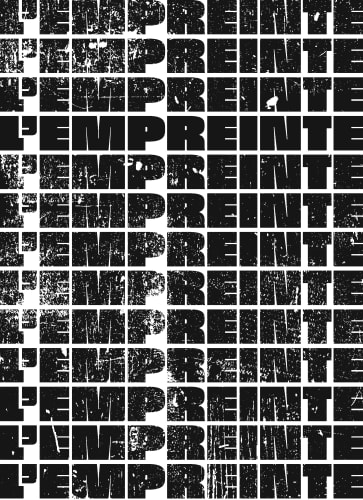Olivier Malingue is pleased to present L'Empreinte, a group exhibition including works by: Eric Baudart, Brassaï, by Ohne Titel, Cai Guo-Qiang, Adrien Dax, Óscar Domínguez, Jean Dubuffet, Marcel Duchamp, Max Ernst, Sam Francis, David Hammons, Georges Hugnet, György Kepes, Yves Klein, Glenn Ligon, Heinz Mack, Meret Oppenheim, Wolfgang Paalen, Gina Pane, Roland Penrose, Man Ray, Ed Ruscha, Rudolf Stingel, Antoni Tàpies, Thu-Van Tran, Raoul Ubac, and Christopher Wool.
The imagery we often associate with the term "imprint" is the one of a feral stamp, left without intention on a path by "someone or something". The mark on the soil becomes proof of a past presence, while making the viewer an indirect witness of its passage.
An imprint can also be made with strategic intent, as a product emanating pre-determined visual references. This meaning of the term illustrates the different possibilities the imprinting process can materialise. Its purpose can be ephemeral or permanent, physical or abstract; its goal to forge values, make socio-political statements or report personal experiences.
Handprints are still among the most archaic ways known to humans to leave an intentional sign on a surface. However, in the exhibition at Olivier Malingue, imprint-related processes, techniques and mediums allow a wide range of alternatives in relation to the development of an artistic body of work. Featuring works that are the result of direct imprints on a surface or the representation of visual narratives associated to the domain of the imprint, the exhibition focuses on how the act and the imagery of the imprint has had an impact on modern and contemporary art.
Over time, the imprint's range of attitudes and meanings has become far more expanded. "Imprint" can be an embossed relief - as in Ed Ruscha's Ghost Station (2011), where absence becomes presence through the fibres of a sheet of paper. Or the impression obtained by rubbing a textured surface - as in the frottage drawings and paintings by Ernst, Penrose and Oppenheim, a technique Ernst started using in 1925, which gives a specific aura to the works on show. An expansion of the concept of the imprint, can take the form of blurred waves, seen in the technique of decalcomania, introduced in the Surrealist movement by Óscar Domínguez. The exhibition also includes several contemporary interpretations of the "imprint". For example, a mural by the Paris-based artist Thu-Van Tran, analyses the artist's historical and cultural roots through the choice of materials employed in her practice. By mixing pigment with latex (rubber), and by applying it to the gallery's entrance wall, Tran identifies the traces left by this material as a symbol of colonial domination throughout history. It is clear how some of these examples transcend the etymologic meaning of "imprint" and the action of "imprinting" - "to press into" (from the latin verb imprimere).
As Emily LaBarge wrote in her essay, which was commissioned to accompany the exhibition, "The perfect stain is the one we live inside of every day, whether we choose to acknowledge it or not; the one that it is our duty to investigate, for it is clear that human beings make their mark-their imprint, l'empreinte-wherever they go".




